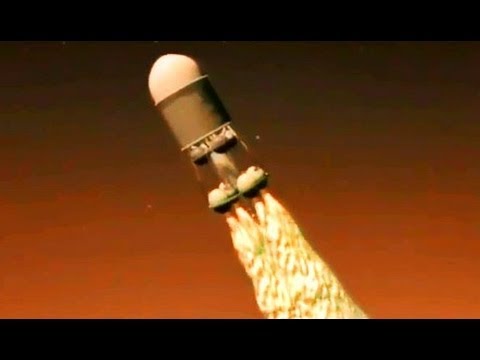more at
“This video was created by NASA JSC’s Missions Planning Division to depict a future unmanned Mars mission. Released Sep. 1988.”
Public domain film from NASA, slightly cropped to remove uneven edges, with the aspect ratio corrected, and mild video noise reduction applied.
The soundtrack was also processed with volume normalization, noise reduction, clipping reduction, and/or equalization (the resulting sound, though not perfect, is far less noisy than the original).
A Mars sample return mission (MSR) would be a spaceflight mission to collect rock and dust samples from Mars and to return them to Earth. Sample return is very powerful type of exploration, because analysis is freed from the time, budget, and space constraints of spacecraft sensors. All of Earth’s laboratories can potentially study a sample.
According to Louis Friedman, Executive Director of The Planetary Society, Mars sample return is often described by the planetary science community as the “holy grail” of robotic space missions, due to its high expected scientific return-on-investment.
Over time several missions were planned but none of the proposed missions got beyond the planning phase. The three latest proposals for a MSR mission are a NASA-ESA proposal, a Russian proposal, Mars-Grunt, and a Chinese proposal.
MSR was highest priority in the Planetary Decadal Survey 2013-2022: The Future of Planetary Science…
Scientific value
The return of Mars samples would be beneficial to science by allowing more extensive analysis to be undertaken of the samples than could be done by instruments painstakingly transferred to Mars. Also, the presence of the samples on Earth would allow scientific equipment to be used on stored samples, even years and decades after the sample return mission.
In 2006, MEPAG identified 55 important future science investigations related to the exploration of Mars. In 2008, they concluded that about half of the investigations “could be addressed to one degree or another by MSR”, making MSR “the single mission that would make the most progress towards the entire list” of investigations. Moreover, it was found that a significant fraction of the investigations cannot be meaningfully advanced without returned samples…
NASA-ESA plan
In mid-2006, the international Mars Architecture for the Return of Samples (iMARS) Working Group was chartered by the International Mars Exploration Working Group (IMEWG) to outline the scientific and engineering requirements of an internationally sponsored and executed Mars sample return mission in the 2018–2023 time frame.
In October 2009, NASA and ESA established the Mars Joint Exploration Initiative to proceed with the ExoMars mission, whose ultimate aim is “the return of samples from Mars in the 2020s”. A first step in this was one particular proposal, a joint project between NASA and ESA called ExoMars, would launch in 2018 with unspecified missions to return the sample itself expected in the 2020-2022 time frame. The cancellation of the caching rover MAX-C and later NASA withdrawal from ExoMars, pushed back a sample return mission to an undetermined date.
Due to budget limitations the MAX-C mission, which was the first NASA-ESA mission leading to a MSR, was canceled in 2011 and the overall plan in 2012. The pull-out was described as “traumatic” for the science community.
NASA proposals…
One-launch architecture
Solar-electric propulsion might allow a sample return by launching all elements in a single launch. By using a Hall thruster powered by solar energy, less propellant would be needed, allowing the lander and return spacecraft to be launched together.
Two-launches architecture
In this scenario, the sample return mission would span two launches at an interval of about four years. The first launch would be for the orbiter, the second for the lander. The rest of the mission would follow in the same way as the one-element mission design.
Three-launches architecture
According to JPL’s Mars Exploration Program manager Fuk Li, a consensus is now forming for a sample return mission split into a total of three launches. In this scenario, the sample-collection rover (e.g. MAX-C) would be launched separately first land on Mars, and carry out analyses and sample collection over a lifetime of at least 500 Sols (Martian days).
Four years later, the orbiter would be launched, followed by the lander including the Mars Ascent Vehicle (MAV). Instead of a full-blown sample-collection rover, the lander would bring a smaller, simple “fetch rover”, whose sole function would be to retrieve the sample container from the sample-collection rover, and return it to the lander where it would be loaded onto the MAV…

